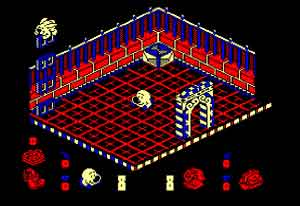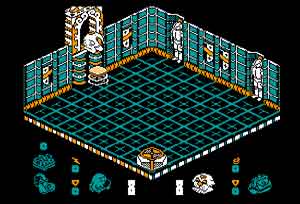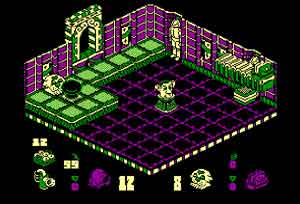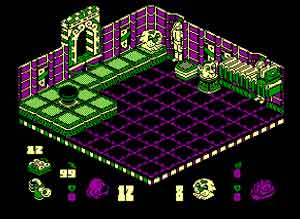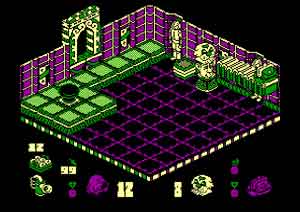december 2003
Jan Van Looy is Teaching Assistant at the Institute for Cultural Studies, K.U.Leuven, Belgium. He is also Project manager and programmer at the Maerlant Multimedia Center.
Uneasy lies the head that wears a crown
Interactivity and signification in Head Over Heels
by Jan Van Looy
The aim of this paper is to investigate – through a close analysis of the 1987 puzzle game Head Over Heels – to what extent media objects can generate meaning by means of their interactive structure. First we will look more closely at the computer game itself: the circumstances in which it was published, its frame story and its game play. Next, we will see how it was received by the Spectrum and Amstrad game community and how it is still highly valued by retro video game enthusiasts today. We will look at four reasons for the popularity of Head Over Heels given by the designers and the game community and propose two more, i.e. its interactive layout and its semantics. In the theoretical interlude we will go deeper into the history and nature of the concepts of "immersion" and "interactivity" in recent digital cultural theory. Finally, we will zoom in on the interactive framework of Head Over Heels using the concepts and theory sketched before, and attempt to substantiate the claim that signification plays a role in the appreciation and reception of interactive media objects.
Head over Heels
Figure1. Splashscreen
Head Over Heels was released in 1987 by Ocean Software, a Manchester (England) based company. Jon Ritman, a television engineer who had been programming games since 1982, provided the concept and did the Z80 programming. Bernie Drummond made the graphics, Guy Stevens the sound effects and the music and F.D. Thorpe the loading picture. Head Over Heels first came out for the Sinclair Spectrum. "When I design a game, it's always built around the limitations of the Spectrum" (Jon Ritman in Kidd, 1988). Afterwards, it was ported to the Amstrad CPC series, MSX, Commodore 64 and Atari XL, and later to the Commodore Amiga and the Atari ST platforms undergoing only minor modifications (TheLegacy, 2002; Ritman, 2001). This paper is based on the Amstrad CPC version, which measures around 195KB and was published in 1987.
Figure 2. Knight Lore, Batman, and Head Over Heels
Head Over Heels is a 3D isometric arcade/ puzzle game based on the graphical engine of Batman (Ritman, 2001). Batman in turn was inspired by Knight Lore (Stamper, 1984), which was the first isometric game that came out for the Spectrum. "I saw Knight Lore soon after I'd finished work on Match Day and decided 'this is the sort of world I like to see a game in – it's just like playing a Disney cartoon'" (Ritman in Kidd, 1986). Isometric games use a simple but ingenious way of simulating three dimensions. The game is divided into rooms where the third and the fourth wall have been taken out. The player is looking down on the scene from a corner. She assumes a neutral third-person stance and a low-flying bird's or an insect's point of view. The avatar can move in four directions. When he moves behind obstacles, he disappears from the user's view. Doors in both the visible and the invisible walls allow the user to move to the next room. Both angle and visibility create a sort of "panic room" atmosphere, where the house is the game itself in which the avatars move around followed by security cameras. Many strategy and roleplaying games still use the 3D isometric formula today.
Figure 3. In prison
The frame story of the game is laid out as follows. In a far distant galaxy lie four worlds enslaved by an evil empire. In each world unrest simmers against the dictatorial Emperor who rules his territories from the planet Blacktooth. Neighbouring worlds fear a similar fate and send two spies from the planet Freedom in order to kindle revolution upon the slave planets and recover the crowns that have been lost. When the game starts, the two spies, Head and Heels, have been captured and separated. First, they have to escape from their prison in the castle headquarters of Blacktooth and proceed to liberate the four occupied worlds: Egyptus, Penitentiary, Safari and Book World. When the crowns of all four slave planets are collected, the Emperor can be killed, and with him the evil Blacktooth Empire. The emperor's death signals the end of Head and Heels's task, and they can return home to their planet Freedom, to be acclaimed as heroes (adapted from Crash, 1987; Armstrong, 2000).
Head and Heels, who look like a Labrador Retriever and a Beagle, are symbiotic creatures with particular skills. Head (Headus Mouthion) descended from flying reptiles. He can jump twice his own height and control his slow descent using his vestigial wings. Heels (Footus Underium) has legs like pistons and is a powerful runner capable of leaping his own height. Moreover, the two protagonists each have their personal object. Head can pick up a hooter, which can be used to fire doughnuts with paralyzing power. Heels can use a bag to pick up and move objects. Once Head is on top of Heels, the player can join them into 'Head Over Heels,' who has all of Head's and all of Heels' strengths and none of their weaknesses. The game uses this feature intelligently sometimes forcing the two to split and then re-combine later. "[T]he characters are separated by clever use of the surroundings, such as jumps that only Head can make, or holes that only a single character can pass through or in one notable case through the inclusion of alien dogs known as Hush Puppies (...) which will disappear if Head enters the room (...), but which are quite happy to co-exist with his leggy chum" (Goring, 2000).
Figure 4. Spring
To escape from prison, both Head and Heels must pass through a series of rooms and corridors, some filled with deadly obstacles like poisonous Marmite jars, electrified floors and attacking monsters – touching these results in evaporation into a cloud of bubbles and losing one of your eight lives. Other objects help Head and Heels in their quest for justice: stuffed rabbits give extra lives, springs allow higher leaping, Prince Charles's head is used to cross electrified platforms, Reincarnation Fish give life after death, doughnuts provide ammunition and teleport platforms transport Head and Heels from room to room and from world to world (based on Crash, 1987; Armstrong, 2000). "Some of the puzzles are fiendish – either hard to work out (...) or requiring finely honed arcade skills (...). Virtually every screen has a different conundrum to solve – some seem impossible on first, second and 43rd sight, but many depend on whether you've chosen Head or Heels (or both) to tackle them" (Berkmann, 1987). Monsters can be artificially intelligent. They are able to spot you and will go after you. Fortunately, they only move in two directions and Heels, who can run faster, is able to lure them away from the much desired entrance to the next room.
Figure 5. Monsters and electrified platforms
The game community
Head Over Heels has been a tremendous success both commercially and in terms of reception. "The game got rave reviews for all versions including, for the first time, the C[ommodore] 64 version" (Ritman, 2001). Today retro video game enthusiasts cherish Head Over Heels. It is described as "definitely the best Ritman/ Drummond game" (Crash, 1987) or "the best [Amstrad] CPC game of all time" (Campbell, 2002). Others go further by calling it the best game in its kind. "After Knight Lore, there were a hundred isometric 3D arcade adventure puzzle games, but this is undeniably the peak of the genre" (Your Sinclair, 1992). "Head Over Heels is the cutest arcade adventure yet" (Crash, 1987). One lone enthusiast suggests that "[i]t's quite possible that this game represents the peak of the game designer's art full stop" (Your Sinclair, 1992). In Issue 39 of Crash (Crash, 1987) Head Over Heels scores best at graphics and playability (presentation: 90; graphics: 97; playability: 96; addictive qualities: 95). On Graham Goring's fan site (Goring, 2000) game play, graphics and lastability score highest (game play: 9; lastability: 9; graphics: 9; use of colour: 6; sound: 7; music: 8; overall: 9). Finally, on The Amstrad CPC Games Resource (Tacgr, 2002), Head Over Heels receives high marks in all categories except sound (graphics: 96; sound: 68; grab factor: 95; staying power: 96; overall: 95).
Designers and players have suggested different reasons for the success of Head Over Heels. They can be grouped into four categories: (1) format and programming, (2) graphics and sound, (3) game play and (4) number of protagonists.
(1) As mentioned earlier, the 3D isometric formula is a more than adequate way of simulating three dimensions without requiring too much processing power – ideal for the home computer generation of the eighties. Compared to Knight Lore, Head Over Heels has easier controls, wider rooms, better graphics and a faster engine. Gravity and speed are proportioned realistically. Head can float across the room and change direction in the air. Heels has a slight acceleration algorithm built into his running which lets him take off nicely. "Movement is smooth, and the collision detection is spot on. Speedwise it's quite healthy and doesn't suffer from much of the slow down that characterises many isometric games" (Goring, 2000).
(2) In view of the limitations of the hardware, many effects in Head Over Heels are beautifully stylized. "The graphics are detailed and full of character – typical of Bernie Drummond's cartoony style – although due to the nature of the isometric layout the usage of colour is very limited, but it's easily forgivable (...). The sound is also well handled with nice plinky plonky effects and likewise muzak-ey pieces when you enter certain rooms around the map" (Goring, 2000).
(3) Gameplay is well-balanced between arcade skills and puzzles which are "[m]ind-wrenchingly devious but always tantalisingly solvable," making the game "so addictive it hurts" (Your Sinclair, 1992). It is a game typically developed for the home computer market rather than the arcade machine or amusement park. It is twice the size of Batman, its predecessor, and contains 301 locations involving "both exploration and lateral thinking" (Campbell, 2002). The reason for both the size and the quality of the puzzles is the fact that Head Over Heels was programmed using the same graphical engine as Batman. This allowed the developers to work in a format they were already familiar with and to focus on graphics, playability and scenario rather than programming. The eighties were the heyday of authorial game production, i.e. one person was responsible for the scenario, the game play and the programming. Perhaps not coincidentally, this was the age when the basis was laid for most computer game "genres."
(4) The greatest innovation in Head Over Heels, both on the technical and the game level, was the use of two protagonists instead of one. The new dimension was hailed as a "stroke of genius" (Tacgr, 2002). However, Ritman speaks very level-headedly about his decision. "It's strange how the use of two characters was hailed as a creative masterstroke but at the time I just thought of it as a way to give slightly more complex puzzles" (Ritman, 2001).
In this paper I will claim that the impact of having two avatars instead of one was more important than is often supposed. In Head Over Heels it is difficult for the player to identify fully with a virtual persona and think in simple terms of herself against the world. Instead, she needs to take care of and depend on two characters at the same time. This bears great consequences for both the emotional involvement of the player and the signification. "Head Over Heels toyed with the player's emotions as he struggled to join up the two independent heroes, only to have the joy of success cruelly shattered by another problem which could only be solved by splitting them up again" (Your Sinclair, 1992). Probably hence the identification process functions alternately and much emphasis is put on the identity of the two personas, which are described as "extremely detailed, very lifelike and cuddly" (Crash, 1987). The main thesis of this study is that there is a fifth reason for the success of Head Over Heels, its interactive framework or, more precisely, the way in which interactivity generates an extra level of meaning to the game. In the next section we will briefly sketch the theoretical basis of the concepts we will use in our analysis. In the analysis itself I will attempt to substantiate the above thesis and draw a number of general conclusions.
Immersion and interactivity
In the 1980s and 90s proponents of hypertext literature like George Landow, Michael Joyce, Stuart Moulthrop and Jay David Bolter presented hyperfiction as the fulfillment of poststructuralist literary theory. Links were considered the materialization of intertextuality. Bricolage or tinkering (Turkle, 1995) was hailed as a liberation of the act of writing and hypertext was described by concepts like decentring, writerly text (Barthes, 1974 through Landow 1997) and différance (Derrida, 1967). Adversaries of the hyperfiction aesthetic (for example, Birkerts, 1994) swore by the warm comforting authorial voice of the novel and compared hyperfiction to being lost in an infinite maze trying to extract meaning out of the meaningless. We will not pursue this discussion any further here. For our purposes, it suffices to note that the dispute revolves around the opposition between looking at and looking in, between being confronted with and being submerged in the text.
In Remediation, Bolter and Grusin (1999) analyze media history teleologically through the opposition between hypermediacy and immediacy. Both tendencies are described as manifestations of a mimetic desire, a desire to depict reality. Through hypermediacy our culture attempts to reach more direct representation by multiplying media, by saturating itself with sources of information. As the name suggests, hypermediacy is associated with hypertext and it may well have been inspired by the typical news website at the end of the nineties where text is combined with images, animation and film. Hypermediatic design is described as privileging "fragmentation, indeterminacy, and heterogeneity and… emphasiz[ing] process or performance rather than the finished art object" (Bolter & Grusin, 1999). Hypermediacy urges the user not only to look at the interface, but also to actively participate in the meaning generation process by offering her multiple channels and paths which she may choose to engage in. Through the logic of transparent immediacy, on the other hand, culture strives "to erase or to render automatic the act of representation" (Bolter & Grusin, 1999). The medium attempts to efface itself so as to present the mediated world as a unified visual space, seamlessly integrated in the environment. The most prototypical example is the cinema theatre where the viewer is submerged in images, sound and darkness.
In Narrative as Virtual Reality, Marie-Laure Ryan starts from the definition of the latter – virtual reality – by Pimentel and Teixeira as an "interactive immersive experience generated by a computer" (Ryan, 2001). From this definition she derives two dimensions, immersion and interactivity, which she develops into the "cornerstones of a phenomenology of reading, or, more broadly, of art experiencing" (2001). The two concepts determine the history of western art which "has seen the rise and fall of immersive ideals, and their displacement, in the twentieth century, by an aesthetics of play and self-reflexivity that eventually produced the ideal of an active participation of the appreciator – reader, spectator, user – in the production of the text" (2001). Importantly, like Bolter and Grusin, she describes immersion and interactivity as opposed forces, which she sees interacting and leading to an ultimate goal in the history of representation, the sublimation of the two concepts in virtual reality. Thereby she associates the aesthetics of immersion with a "'world' that serves as environment for a virtual body," and that of interactivity with a text presented as a "game, language as a plaything, and the reader as the player" (2001), descriptions that derive from poststructuralist theory as it was advanced by hypertext theorists (cf. supra).
In the fourth chapter of The Language of New Media titled "The illusions" Lev Manovich invokes a similar opposition. "In the twentieth century, art has largely rejected the goal of illusionism, the goal that was so important to it before; as a consequence, it has lost much of its popular support. The production of illusionistic representations has become the domain of mass culture and of media technologies – photography, film, and video" (Manovich, 2001). But Manovich does not directly associate the artistic side of the opposition with interactivity. Instead, in the fifth subsection called "Illusion, Narrative, and Interactivity" he confronts illusion (cf. looking through, immediacy, immersion) with interaction as two concepts from a different realm that work with and against each other. More precisely, he notes that many digital artifacts "are characterized by a peculiar temporal dynamic – a constant, repetitive oscillation between an illusion and its suspense. These new media objects keep reminding us of their artificiality, incompleteness and constructedness. They present us with a perfect illusion only next to reveal its underlying machinery" (Manovich, 2001). In the next section, I will attempt to demonstrate that it is the oscillation brought about by the interplay between immersion and interaction that accounts for Head Over Heels's peculiar semantics.
Immersion, interaction and signification in Head Over Heels
Figure 6. Head helping out Heels
As Ryan suggested, immersion is associated with transportation to a virtual world. In Head Over Heels the player controls one character at a time. She has to jump over obstacles, avoid monsters and collect objects. Puzzles, however, in a sense break the immersive ideal. The player walks into a room and sees that she cannot go any further without finding a successful strategy to get to the next room. This is a first break, a first immersive collapse. Next, she will try all the objects that are available in the room. She will move the spring or the boxes or fiddle with the virtual joystick. If she finds the solution she can start walking around again and immersion will quickly reclaim its terrain. If she does not find the solution, there is a second immersive collapse and this is where Head Over Heels differs from most other puzzle and arcade adventures. It is possible that you cannot solve the puzzle, i.e. you cannot solve it alone. The player can now switch protagonists. She can try if Head can find his way to Heels's room or Heels to Head's so that they can solve the problem together. At this point, immersion is neutralized by a call for interactivity in that the player no longer directly identifies herself with one virtual body (cf. Ryan), but two. The player unties herself from the avatar and is pushed to develop a new view on the scene. This interruption of the identification process functions as a feedback loop for signification. The player has to think for two, and identify with two avatars at the same time. This creates an atmosphere of solidarity. Head has to work for Heels and vice versa. The breach in the identification process leads to an easier acceptance of the identities of the two creatures. As a player, you start to see them as separate entities, not just as yourself. You never feel alone in Head Over Heels. This makes it a game about friendship and love.
Figure 7. Poster
Heels is a strong-legged, stocky and sturdy version of a Beagle with heavy whiskers and coat. Head looks like a freshly shaved friendly-looking Labrador Retriever with wings instead of ears. Although the promotional poster speaks of Mr Head, the question whether Head and Heels could not be girl and boy urges itself. One indication of Head's femininity is that every now and again she blinks with her eyes, a typical trait of feminine representation. Moreover, the promotional poster to Head over Heels reads "The last time we entered Castle Blacktooth we found the crowns of Three of the suppressed kingdoms (…) we were jumping for joy, splitting our sides, dying with laughter… we were Head Over Heels" (Ritman, 1987). This use of the expression 'head over heels' corresponds to its first meaning, "Rolling, as in a somersault: [e.g.] tripped and fell head over heels" (AHD, 2002). In this first meaning the title refers to the game play where puzzles have to be resolved by jumping, pushing and falling from obstacles. However, the title also carries a connotation of the second meaning of 'head over heels': 'completely, hopelessly,' as in 'head over heels in love' (AHD, 2002). If Head and Heels represent the feminine and the masculine respectively, could their relationship not be one of love, and the quest in the game a metaphor for life?
Figure 8. 'Head Over Heels'
When the game starts Head and Heels are separately imprisoned. In order to establish unification, both of them have to pass through a number of ordeals and both have to bring a dowry: Head a hooter and doughnuts, and Heels a bag. It is Head (the girl) who has to solve the highest number of puzzles in order to reach the market, where she will meet Heels. When Head and Heels come together, Head jumps on top of Heels, which carries strong sexual connotations while defying tradition and for canine species biology (girl on top of boy). When the player presses the switch button the two are joined and "Head sits like a lady's Sunday bonnet on Heels' head" (Crash, 1987). Now that Head and Heels are together they combine strengths and lose weaknesses; 'Head Over Heels' can run as fast as Heels and jump as high as Head. This entails, however, that they can jump further because of the faster take-off run and more easily escape from monsters, because they can jump over obstacles Heels alone would not dream of jumping over. Furthermore, they can solve more complex puzzles; for example, when one of the two guides the other across an electrified platform or when Heels builds a tower of boxes so that with Head's high jump they can go to the next room. The whole is more than the parts. Once joined, the couple is stronger than ever, but finishing the quest together is not self-evident. One of the two may die in the attempt or one may get stuck and give up underway. Interestingly, on this second allegorical level the player is no longer one of the protagonists or both, but rather unification itself. She finds the two forced to separate and she has to bring them back together. On the first level, the aim of the game is to avoid monsters, solve riddles and liberate planets. On the second level, it is to lead a fulfilling life with a loving partner.
Figure 9. On Charles' head
Finally, for a contemporary English audience there may have been one more semantic dimension to Head Over Heels. In an interview, Bernie Drummond who did the graphics explains that on screen he works more like a sculptor than a draftsman. "Pixel manipulation is very strange – things look very different on screen compared to the way they might look on paper. If you've got a character with a head that doesn't look round, adding a couple of pixels can make the head round and make a couple of ears" (Kidd, 1988). Drummond may well be referring to the Prince Charles graphic he made a few months earlier for Head Over Heels. At several occasions in the game, there are puzzles where Head or Heels move a chess piece suspiciously similar to the crown prince of England. Charles is controlled with a joystick by the avatar. On the first semantic level of the game this act is metonymically self-reflexive, referring to the act of playing the game; the player controls a virtual persona who controls a virtual persona. On the second semantic level, the puzzle metaphorically refers to the way in which Charles has been manipulated to marry Diana. By the mid-eighties signs began to emerge that the couple's interests had started to diverge. By 1986, Charles began to see his old love, Camilla Parker Bowles, again, while Diana developed bulimia nervosa and reportedly even attempted suicide (CNN, 2002). Anyhow, although the separation of Charles and Diana was announced only in 1992, by 1987 it had become apparent to the British public that the fairy tale couple was no longer what it pretended to be. This is the atmosphere in which Head over Heels has been programmed and released. Thus, when Drummond recognised Charles in the head and ears he had just drawn, this must have rung a bell and when Ritman was building the puzzles the public discussion may have subconsciously evoked a particular treatment of the matter. In most puzzles involving Charles the chess piece, Head or Heels have to jump on top of his head to reach the other side of the room. In a way, Charles and Diana also had to gather the crowns of the Commonwealth, but they ultimately failed and it was all on Charles' head.
Conclusion(s)
In this paper we have inquired into the interactive nature of the 3D isometric video game Head Over Heels. We have seen how it was built around the technical limitations of the Sinclair Spectrum home computer, how it is accompanied by an extensive frame story and how it consists of complex but intelligent game play. Next, we have looked at a few claims that have been made regarding the quality and "lastability" of Head over Heels. We have grouped a number of reasons for its popularity under four categories – format and programming, graphics and sound, game play, characters – and proposed two more categories: its interactive framework and its semantics. In the theoretical interlude we have seen how different theorists like Landow, Bolter and Grusin, Ryan and Manovich accentuate different aspects in the conceptual nature of immersion and interactivity. We have described how the meaning generation process in Head Over Heels is determined by the oscillation between immersion and interactivity, between being in the virtual world and looking at its representational technology. The use of two protagonists having to work together forces the player to develop an alternate view on the virtual world. Head Over Heels creates an atmosphere of solidarity, friendship and love. This leads us to an allegorical reading of the game in terms of love and marriage which for a contemporary English audience may have carried references to the failed marriage between Charles and Diana.
References
AHD (2002). American Heritage Dictionary of the English Language, fourth edition. http://www.dictionary.com/
Aldridge, Nick (2001). "Head Over Heels" http://www.aldridge98.fsnet.co.uk/headoverheels.html
Armstrong, Ian (2000). "So What's The Story Then..." http://www.iarmst.demon.co.uk/specgame/h.htm
Bee, Philip. "Interview with Jon Ritman" November 1997. http://www.geocities.com/TimesSquare/Battlefield/8875/jritman.html
Berkmann, Marcus (1987). "Head Over Heels" in Your Sinclair 18, June 1987. Ludlow: Newsfield. http://www.ysrnry.co.uk/articles/headoverheels.htm
Birkerts, Sven (1994). The Gutenberg Elegies: the Fate of Reading in an Electronic Age. New York: Fawcett Columbine.
Blood. "Interview with Jon Ritman" in Emulate! issue six, Autumn 1996. http://www.geocities.com/TimesSquare/Battlefield/8875/jritman.html
Bolter, Jay David & Grusin, Richard (1999). Remediation: Understanding New Media. Cambridge, Massachusetts: The MIT Press.
Campbell Nicholas (2002). "Head Over Heels" in CPC Game Reviews. http://www.cpcgamereviews.com/h/index.html
CNN (2002). "Irreconcilable Differences: the royal divorce" in CNN interactive. http://www.cnn.com/WORLD/9708/diana/differences/
Crash (1987). "Head Over Heels" in Crash 39, April 1987. http://www.mjwilson.demon.co.uk/crash/39/headheels.htm
Derrida, Jacques (1967). De la Grammatologie. Paris: Editions de Minuit.
Goring, Graham (2000). "Head Over Heels" http://www.duketastrophy.demon.co.uk/spectrum/specrevs/headheel/review.htm
Kidd, Graeme (1986). "The Jon Ritman Interview: Graeme Kidd talks to the man behind classics like Batman and Match Day" in Crash 33, October 1986. Ludlow: Newsfield.
Kidd, Graeme (1988). "Jon Ritman and Bernie Drummond" in Your Sinclair Issue No. 32, August 1988. http://www.geocities.com/TimesSquare/Battlefield/8875/ysjrbd.html
Landow, George P. Hypertext 2.0: The Convergence of Contemporary Critical Theory and Technology. Baltimore: John Hopkins UP, 1997.
Manovich, Lev (2001). The Language of New Media. Cambridge, Massachusetts: The MIT Press.
Ritman, Jon (1985). Batman. Manchester, England: Ocean Software.
Ritman, Jon (1987). Head Over Heels. Manchester, England: Ocean Software.
Ritman, Jon (2001). Personal Webpage. http://www.ritman.co.uk/
Ryan, Marie-Laure (2001). Narrative as Virtual Reality: Immersion and Interactivity in Literature and Electronic Media. Baltimore and London: The John Hopkins University Press.
Stamper, Tim & Stamper, Chris (1984). Knight Lore. Ashby-de-la-Zouch: Ultimate.
Tacgr (2002). The Amstrad CPC Games Resource http://tacgr.emuunlim.com/downloads/filedetail.php?recid=418
TheLegacy (2002). http://www.thelegacy.de/
Turkle, Sherry (1995). Life on the Screen: Identity in the Age of the Internet. New York: Simon & Schuster.
Your Sinclair (1992). "The Your Sinclair Official Top 100 Part 4" in Your Sinclair 73, January 1992. Ludlow: Newsfield. http://www.ysrnry.co.uk/articles/ystop100_4.htm
© 2001 - 2004 Game Studies
Copyright for articles published in this journal is retained by the journal, except for the right to republish in printed paper publications, which belongs to the authors, but with first publication rights granted to the journal. By virtue of their appearance in this open access journal, articles are free to use, with proper attribution, in educational and other non-commercial settings.



